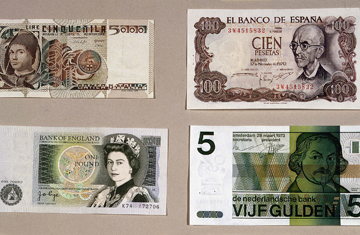
Old banknotes from different countries: Italy, Spain, England, Netherlands, Germany, Swiss and Japan.
If you ever wondered what happened to all those pesetas when Spain officially converted its currency to the euro, the tiny town of Mugardos might have the answer. Located in the northwestern region of Galicia, the coastal village began accepting the abandoned currency on March 1, and has since discovered what many have suspected all along: despite having the option to trade in their pesetas for euros, many Spaniards still have a lot of the old bills and coins tucked away in drawers and under mattresses.
In an effort to boost spending during hard times, 61 of Mugardos' businesses are participating in the campaign, which allows clients at shops and restaurants to spend their languishing pesetas at the rate of 166.38 to the euro — precisely the exchange on Jan. 1, 2002, the day the latter went into effect. "We knew that people were hurting because of the economy," says Felipe Fernández, owner of the Kiosco Loli, which sells magazines, toys, and souvenirs. "We thought this might be a good way to motivate them to spend."
With the campaign just one week old, it's too early to say whether it will help stimulate the economy of the 5,500-resident town. But anecdotally, local merchants say they've noticed an uptick in spending. Although Fernández has had only three customers pay in pesetas, one of them came from outside of town. And he's heard from other businesses, like some of the town's bars, that they're seeing more customers. "One of them even came in and paid with a 10,000-peseta bill," he says. (He got his change in euros.)
"We're getting people who otherwise wouldn't have come to our town," says Juan Rey, who, in addition to owning the local hardware store, is secretary of the Merchants' Association, which launched the campaign. "A lot of people have pesetas lying around."
Just how many is difficult to calculate, but the Bank of Spain puts the total amount of pesetas still in circulation at 1.7 billion. That sounds like a lot, but is in fact just 3.5% of what was in circulation on the last day of the peseta's reign. Which is partly why the state bank isn't very concerned about Mugardos' efforts. "As long as it continues to accept the legal currency, which is the euro, any business has the right to work out an agreement with its customers for how goods are exchanged," says Nuria Horcajada, spokeswoman for the Bank of Spain. "And we've seen this kind of thing before — shops, for example, that will take pesetas for the publicity."
What the Mugardos campaign doesn't mean, says Horcajada, is that Spain is returning to the old currency. Rey, the Merchants' Association secretary, agrees. "I've seen things in the media about how we're doing this because we want to go back to the peseta, but that's just not true," he says. "We're just doing it to see if it helps our local businesses."
At the end of March, participating merchants will slip their hard-earned pesetas into envelopes and turn them into the association, whose board members will take them to the nearest branch of the Bank of Spain — some 30 miles away in A Coruña — to exchange them for euros. But Rey doesn't rule out the possibility that the campaign will continue. "We're talking about it," he says. "If this works, maybe we'll just keep accepting pesetas."
